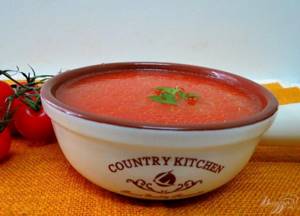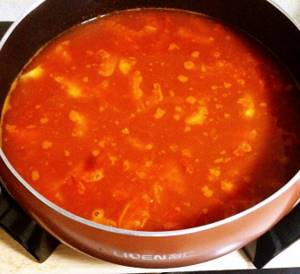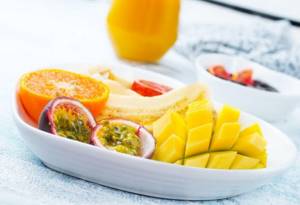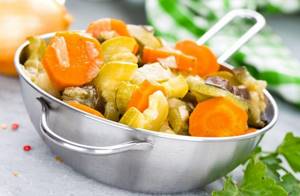Tomato soup for weight loss is a healthy and very tasty dish that allows you to correct your figure. We bring to your attention two recipes for its preparation.
Useful properties of tomato soup for losing weight
Dietary tomato soup includes only low-calorie ingredients - the main component of this dish, of course, is tomatoes.
Tomatoes are low in calories (20-25 kcal/100 g). The healthy pulp contains organic acids (tartaric, malic, citric) - they stimulate metabolism, and therefore activate the burning of fat. Tomatoes contain vitamins (B, PP, E, K), as well as large amounts of ascorbic acid and carotene.
Tomato soup provides our body with minerals (it is worth highlighting iodine, magnesium, zinc, sodium, iron, manganese). Tomatoes dull the feeling of hunger, provide a diuretic and mild laxative effect.
Is the dish suitable for weight loss?
Tomatoes not only have a whole range of useful substances, but are also low in calories, which makes them indispensable in the diet. More than 90% of the composition of a tomato is water, so per 100 grams of this product there are only 20 kcal.
One of the elements in the chemical composition of the vegetable is lycopene. It is not only responsible for the color of the vegetable, but is also actively involved in the process of breaking down fatty tissue. Another micronutrient, chromium, suppresses appetite and dulls the feeling of hunger. Dishes with tomatoes without the use of mayonnaise, fatty sour cream and large amounts of vegetable oil will never harm your figure.
Be sure to check out:
Recipe for tomato soup “Coolness”
For preparation you will need:
• Tomatoes (about a kilogram); • Carrots (one piece); • Herbs and spices (optional).
First, you need to remove the skin from the tomato. To do this, scald them with boiling water and then plunge them into ice water. After this, remove the skin and chop the tomatoes. Carrots need to be chopped using a grater. Finely chop the greens. Mix all the ingredients, add spices and enjoy the amazing taste.

The benefits and harms of tomatoes
Tomatoes are a source of many micronutrients responsible for the normal functioning of the body. Among them are magnesium, zinc, potassium, iodine and calcium. They are rich in iron, necessary for the complete delivery of oxygen to tissues involved in hematopoiesis and preventing anemia, and vitamins of groups A, B, C, E, PP. Of particular importance for those on a diet is vitamin K, which is involved in metabolism and is responsible for the tone of the vascular wall and the processes of blood clotting and the absorption of a number of substances by the body.
Interesting! Lycopene not only prevents the accumulation of fats, but is also characterized by high antioxidant activity, which additionally prevents cancer.
Expert opinion
Evgeniy Kislitsa
Practicing surgeon. Certified massage master. Two-time vice-champion and heavyweight champion of regional kettlebell lifting competitions.
Antioxidants belong to a group of natural substances that prevent the development of cancer. This is due to the fact that antioxidants prevent lipid peroxidation in the body, which results in the formation of peroxides in cells. It is the latter that can disrupt the functioning of cells and lead to the appearance of mutant cells that actively divide and can produce unlimited offspring from the same mutant cells. It is from them that tumors are formed, including malignant ones, that is, cancer develops. The greater the antioxidant activity and the more such substances are in the body, the lower the risk of developing a malignant neoplasm, that is, oncological pathology.
The beneficial properties of tomatoes also include:
- strengthening the heart muscle and normalizing heart rate, normalizing blood clotting processes (potassium);
- strengthening immunity (vitamin C);
- normalization of the gastrointestinal tract;
- blood pressure stabilization;
- a decrease in blood viscosity in those who have increased blood viscosity;
- normalization of the liver and intrahepatic bile ducts;
- low glycemic index (GI), due to which tomatoes do not cause a spike in blood sugar, but supply the body with glucose for a long time;
- prevention of varicose veins;
- removal of toxic compounds from the body due to increased urination;
- fight against depression (tyramine).
In this case, the consumption of tomatoes should be moderate, since their excessive consumption can provoke an exacerbation of gastric and duodenal ulcers, the formation of kidney stones or their release in the presence of urolithiasis due to the presence of oxalic acid in them. For the same reason, you should not eat tomatoes if you have gout. In small quantities they are allowed on the table for arthritis, peptic ulcer of the stomach and duodenum in the inactive phase and chronic pancreatitis.
Expert opinion
Evgeniy Kislitsa
Practicing surgeon. Certified massage master. Two-time vice-champion and heavyweight champion of regional kettlebell lifting competitions.
Oxalic acid is the main substance that causes the development and exacerbation of gout in an already sick person. This is due to the fact that its excessive accumulation disrupts the processes of protein breakdown and absorption and biotransformation. Therefore, it is recommended to avoid consuming tomatoes for those who suffer from this disease, especially if tophi have already formed - characteristic deposits of minerals in the joints.

Tomatoes can cause diarrhea, but only if a lot of vegetable oil was used in their preparation. With such a combination, the laxative effect of vegetable oil, which itself is an active natural laxative, increases.
Menu for the week
Days cannot be rearranged. Cook vegetables, rice, chicken, fish strictly without salt, using gentle methods (cooking in boiling water or steaming, baking without oil).
Monday

Fruit day, daily calorie content - about 880 kcal.
- Breakfast: 100 g of soup, 300 g of pears, tea.
- Snack: 100 g soup, 200 g tangerines.
- Lunch: 150 g of soup, 300 g of apples, fruit juice.
- Second snack: 150 g apples.
- Dinner: 150 g soup, 150 g pears, 200 g oranges.
Tuesday

Vegetable day, daily calorie content is about 960 kcal.
- Breakfast: 100 g of soup, 200 g of stewed vegetables (pumpkin with onions, carrots and bell peppers).
- Snack: 100 g soup, 100 g cucumber.
- Lunch: 100 g of soup, 200 g of stewed vegetables (pumpkin with onions, carrots and bell peppers).
- Second snack: 250 g beets.
- Dinner: 100 g of soup, 200 g of baked potatoes, 100 g of fresh cabbage salad with carrots.
Wednesday
Vegetable/fruit day, daily calorie content is about 950 kcal.
- Breakfast: 100 g of soup, 200 g of stewed vegetables (cabbage with onions and tomato paste), 150 g of pears.
- Snack: 100 g soup, 150 g beets.
- Lunch: 100 g of soup, 300 g of apple and carrot salad, dressed with vegetable oil (1/2 teaspoon).
- Second snack: 150 g of orange, cranberry juice.
- Dinner: 100 g soup, 200 g stewed vegetables (cabbage with onions and tomato paste), 150 g pears.
Thursday
Milk day, daily calorie content is about 1300 kcal.

- Breakfast: 100 g of soup, 200 g of cottage cheese 2%, 50 g of yogurt 3%, 1 banana.
- Snack: 100 g soup, 200 g yogurt 3%.
- Lunch: 100 g soup, 200 g cottage cheese 2%, 50 g yogurt 3%, 1 banana.
- Second snack: 100 g of soup, 200 g of 3% yogurt.
- Dinner: 100 g soup, 200 g cottage cheese 2%, 50 g yogurt 3%, 1 banana.
Friday
Meat/fish day, daily calorie content - about 1400 kcal.
- Breakfast: 100 g of soup, 100 g of baked skinless chicken, 200 g of tomatoes.
- Snack: 100 g of soup, 90 g of baked skinless chicken, 200 g of tomatoes.
- Lunch: 100 g of soup, 100 g of baked skinless chicken, 200 g of tomatoes.
- Second snack: 100 g of soup, 90 g of baked skinless chicken, 200 g of tomatoes.
- Dinner: 100 g soup, 200 g boiled squid, 200 g tomatoes.
Saturday
Vegetable/meat day, daily calorie content is about 1600 kcal.
- Breakfast: 100 g of soup, 100 g of boiled beef, 150 g of beets.
- Snack: 100 g of soup, 100 g of boiled beef, 150 g of beets.
- Lunch: 100 g of soup, 150 g of boiled beef, 200 g of stewed vegetables (zucchini, carrots, sweet peppers and onions).
- Second snack: 100 g of soup, 100 g of boiled beef, 150 g of beets.
- Dinner: 100 g of soup, 150 g of boiled beef, 200 g of stewed vegetables (zucchini, carrots, sweet peppers and onions).
Main conclusions
Tomato soup is a simple and tasty way to lose weight, especially in the summer, when prices for this type of vegetables (or rather, berries) decrease noticeably:
- Lycopene, contained in large quantities in tomatoes, allows you to lose weight on a tomato diet.
- In addition to lycopene, the chemical composition of tomatoes is rich in vitamins of various groups, micronutrients and fiber.
- Those who suffer from peptic ulcers or gout in the remission phase (the period when the disease is not active) must carefully introduce this vegetable into their menu, otherwise the disease may become active - the exacerbation phase.
- The benefits of eating tomatoes are enormous. Tomato is able to resist many diseases: from cancer to varicose veins.
A large number of recipes for light and dietary tomato soups will make the menu of a person on a diet very varied and “not boring”. As a result, the restriction stage will be overcome much easier.
Share your experience of “losing weight on tomatoes,” as well as the most original recipes for first courses made from tomatoes.
Ingredients:
- Chicken broth - 150 Milliliters
- Red tomatoes – 1 kilogram
- Onion – 1 piece
- Garlic – 3 cloves
- Fresh green basil – 10 grams
- Fresh cilantro – 10 grams
- Fresh parsley – 10 grams
- Thyme – 3 Grams
- Marjoram - 0.5 teaspoons
- Ground chili pepper - 0.5 teaspoons
- Rosemary leaves - 1/4 tbsp. spoons
- Ground paprika - 1 teaspoon
- Salt - 1 teaspoon
- Olive oil – 40 Milliliters
Number of servings: 4
Cooking rules
Tomato soup is an easy dietary option for the first course, unless, of course, you add cream and vegetable oil to it in large quantities. The basis of any tomato soup is, of course, tomatoes. Fleshy fruits are best suited; they are freed from skin and seeds and crushed in a blender or any other available method.
Despite the fact that today you can buy tomatoes all year round, many people prefer to prepare tomato soup in winter from tomatoes canned in their own juice. Because winter varieties of tomatoes are very tough and do not have the pronounced taste that is inherent in fruits grown in the ground.
Various products can be used as additives to the tomato base. It could be vegetables, herbs, legumes, seafood, chicken or meat.
Tomato soup can be served hot or cold; in summer, of course, the second option is preferable, and in winter it is better to prepare a hot version of the dish.
Interesting fact: the famous Spanish gazpacho soup used to be a traditional food for mule drivers; this cold, liquid dish satisfies not only hunger, but also thirst. Before tomatoes brought by Columbus from South America spread to Europe, gazpacho was made from olive oil, garlic, vinegar, water and bread cubes.
Andalusian hot gazpacho
If desired, you can also prepare hot gazpacho; this version of the soup is offered in Andalusia (part of Spain).
- 4 large fleshy tomatoes;
- 1 large bell pepper;
- 2 cloves of garlic;
- 5-6 tablespoons of vegetable (preferably olive) oil;
- salt, pepper to taste;
- stale wheat bread – 1 kg;
- 1 small orange.
Place 250 grams in a large saucepan. piece of bread and place the washed tomatoes. Pour water so that it covers the components and place it on the stove. Bring to a boil, cook for one minute. Then we remove the tomatoes and the bread into another. Do not pour out the water yet, it will be needed to dilute the puree soup. When the tomatoes have cooled a little, remove the skins from them.
We crumble the remaining bread by hand, remove the crusts, and set the crumbs aside for now. Place the soaked bread, peeled and chopped tomatoes, and pieces of peeled bell pepper into a blender bowl and beat everything until pureed. Then add the bread crumbs and beat again.
Historical reference
Not a dozen years passed until the moment when the senor tomato found its way into the soup. In addition, the tomato did not immediately turn out to be a tasty vegetable, because... back at the end of the 18th century. in many countries it was grown as an ornamental poisonous plant with very pretty red fruits. Like some other beautiful things, the tomato has retained an amazing legend. During the Anglo-American War, George Washington had a cook in his service who was actually an English agent. Having decided to poison the commander-in-chief of the American army and knowing the myth about the poisonous nature of tomatoes, the cook added them to the roast. To his surprise, George found the red berries extremely tasty, after this meal he lived for another 23 years, and the cook committed suicide out of despair. This curious incident occurred in the summer of 1776, and only in 1825. tomatoes were included in food lists under the name "edible paradise". Today, tomatoes are grown everywhere, and in many yield indicators they are ahead of most vegetables and fruits.











